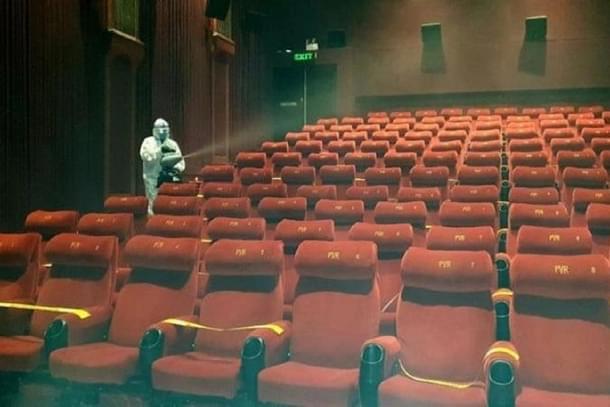Movies
PVR-Inox Downing Shutters On 50 Screens After Massive Losses — What It Reveals About Bollywood’s Health
Sanjeev Newar and Swati Goel Sharma
May 18, 2023, 02:49 PM | Updated 02:46 PM IST
Save & read from anywhere!
Bookmark stories for easy access on any device or the Swarajya app.


Leading multiplex chain operator PVR-Inox has announced plans to shut down 50 screens and has reported a net loss of Rs 333 crore for the quarter ended March.
In its investor’s update for the fourth quarter and financial year ending 31 March 2023, the company, which has been created after the merger of country’s top two multiplex operators PVR Ltd and Inox Leisure, said, “The company plans to shut down approximately 50 screens over the next 6 months.”
PVR-Inox controls one-third of box-office share in India. As per a report by Kotak Institutional Equities, PVR-Inox controls 18 per cent screen share (43 per cent share in multiplex screens in India) and 30 per cent box-office share (over 50 per cent share of multiplex box-office).
In a post-earnings presentation, PVR-Inox said that the contribution of Bollywood movies in its box office share, including the Hindi-Urdu dubbed versions of other languages, has fallen to 51 per cent in Financial Year 23 from 60 per cent during the pre-pandemic period.
Ironically, the development has come barely a few months after the release of Pathaan, which filmmakers and analysts insist is the highest grossing Bollywood film ever with a net box office collection of Rs 530 crore, surpassing Bahubali 2.
Before Pathaan, Brahmastra: Part One – Shiva, was touted to be a blockbuster.
The announcement has sent alarm bells in Bollywood and related businesses. Since then, prominent market observers have begun speculating that the Mumbai-based Urdu-Hindi industry might be “losing its charm”.
In two pieces last year (here and here), these authors detailed how the Bollywood industry crashed and might be facing an imminent demise.
Taking into the account the recent announcement by the company, here is where Bollywood seems to stand right now:
Pathaan’s Hyped Success
Given its market share, PVR-Inox’s success and failure can be taken to be representative of the success and failure of Bollywood itself. An allegedly massive hit like Pathaan should have boosted the business of PVR-Inox, but has instead brought it massive losses.
In Q4FY23, PVR's net loss is Rs 334 crore; the corresponding figure for Q4FY22 was Rs 105.5 crore. Its revenue in Q4FY23 is Rs 1,164.9 crore, almost double of Rs 578.7 crore in Q4FY22.
This suggests that the per-ticket profitability has significantly gone down.
It may be remembered that at the height of Pathaan’s advertised success, the price of tickets for it was slashed, and ‘buy 1 get 1’ deals offered. Additionally, the PR and marketing efforts made for the film were of a scale unheard of.
All this have perhaps increased the cost so much that despite increased sales, losses for the company are much higher than before.
Share price of PVR-Inox has continuously dipped since the release of Pathaan, touching a fresh 52-week low on Tuesday after its Q4 numbers for FY23.
Interestingly, share price of PVR-Inox had also steadily dipped after the release of Brahmastra last year in a similar way. It reversed slightly in December when Drishyam 2 — a scene-by-scene remake of a Malayalam hit film became successful.
These authors had written then that the success of Drishyam 2 is only bad news for Bollywood because the film represents everything that is antithesis of what has been Bollywood's recipe for success so far.
A company’s share price represents the investor’s expectation of the total future earnings. The dip in PVR-Inox’s share price suggests that the investor is scared of, instead of welcoming, the spate of announcements made by the industry regarding upcoming films.
The success of The Kerala Story is unlikely to arrest this downward slide because the film represents everything that Bollywood doesn't. In fact, the film, like The Kashmir Files, has received a cold response from the Bollywood fraternity. Unless Bollywood announces a slew of films with similar themes, success of such films is only bad news for the industry.
The big-ticket, big-star movies that are slated to release this year are Adipurush featuring Telugu actor Prabhas of Bahubali fame; Rocky Aur Rani Ki Prem Kahani featuring Ranveer Singh and Alia Bhatt, Animal featuring Ranbir Kapoor, Jawan and Dunki featuring Shah Rukh Khan and Tiger 3 featuring Salman Khan.
Recent films of these actors — Cirkus and Jayeshbhai Jordaar featuring Ranveer, Shamshera featuring Ranbir and Kisi ki Bhai Kisi Ki Jaan featuring Salman — failed miserably at the box office.
Jawan is being repeatedly postponed; from its original release date of 2 June, the film was first pushed to end of June, but an announcement made last week said the film would be released in September.
For Adipurush, filmmakers were forced to rework the graphics and postpone its release by five months after its teaser in January triggered public backlash for poor quality.
Yet another film to be released this year that got mired in controversy is Satyaprem ki Katha featuring Kartik Aryan and Kiara Advani. The film’s original title 'Satyanarayan Ki Katha' was criticised for mocking religious beliefs of Hindus.
Reviewers And Influencers Misleading The Public, Manipulating The Market
Even before the film Pathaan was released, a number of influencers and a spate of articles in the media called the advance bookings a “tight slap to #BoycottBollywood gang”. Then came the calls for “revenge watching” to make the film a success, if only to beat the online hashtags.
One such article published in India’s largest English daily, The Times of India, praised “SRK fans” who “braved the early morning chill” and “stood for hours in long queues” to watch the film to avenge Shah Rukh Khan’s critics. The article quoted viewers to say that they thought the film was trash.
A sentiment was stirred up against the so-called ‘Boycott Bollywood gang’ to make the act of buying a ticket and watching Pathaan look like a contribution to a social revolution.
Film reviewers who should have evaluated the film on the originality and quality of its content given its budget of more than Rs 225 crore and told the public the truth, instead seemed to act as PR agents for the film in their imaginary battle against a virtual movement.
After the release of the film’s teaser itself, several videos surfaced on social media suggesting that several action sequences, dialogues and songs from the film were a bit too much “inspired” from existing cinematic works.
Since the film’s release, social media is replete with evidence and discussions on plagiarism regarding the film, and how almost every acclaimed or money-making creative work from Bollywood features such “inspirations”.
Bollywood has faced allegations of plagiarism since its inception and that is definitely creating disenchantment.
It does raise a big question mark on film reviewers who ignore this most fundamental criteria of evaluating any art — originality.
The result is for all to see. With such market manipulation tactics, the public trust in the quality of the product as well as credibility of reviewers and trade analysts has gone down. The right term for current market meltdown is hence price correction.
Bollywood’s Continuing Dismissal Of Anti-Bollywood Sentiment Is Proving Costly
At the beginning of this year, a group of Bollywood actors met Uttar Pradesh Chief Minister and publicly asked him to request Prime Minister Narendra Modi to intervene and stop the “Boycott Bollywood hashtag on social media”. Actor Suniel Shetty said that the hashtags would stop if the government wants so.
As earlier pointed by these authors, Shetty’s statement revealed the Bollywood industry’s mindset of denial of the underlying reasons behind the movement and their ignorance of the ones driving it.
Well, the movement is driven by the public and the trigger is Bollywood’s problematic content — something the industry continues to deny, blaming it instead on some political conspiracy.
As pointed out in this earlier piece, some of the reasons that have led to Bollywood’s steep downfall are:
Selective activism over social issues, religious propagation that favours the interests of neighbouring countries and harms India internally, a long legacy of mockery of Hindu beliefs and customs, arrogance on the part of ‘stars’ almost all of whom are from families with a long legacy in Bollywood, lack of creative talent and hard work, disproportionate reliance on a group of men who take home an exorbitant chunk of the budget, total disconnect between the ‘stars’ and audience, and evidence of serial plagiarism.
If Bollywood acknowledged this reality, its biggies would have humbly reached out to social media influencers driving the anti-Bollywood movement for discussions and conversations.
It is quite well known that one of the early — and among the major — drivers of the movement is the fan base of actor Sushant Singh Rajput who died mysteriously in June 2020. The Bollywood biggies should have met Sushant’s family members who continue to demand a high-level probe into his death.
The industry should have also worked out a mechanism to withdraw content that has hurt the sentiments of the majority population, who have long been the butt of jokes in Urdu-Hindi films.





